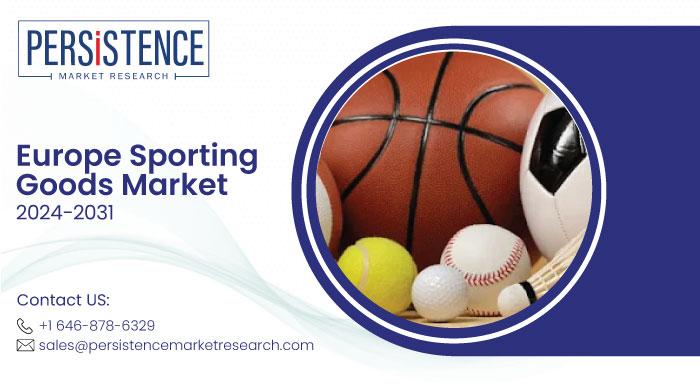Sports
Europe Sporting Goods Market Poised for Explosive Growth, Valued at US$ 436.7 Billion by 2033

The European sporting goods market is poised for significant growth over the next decade, with projections indicating a compound annual growth rate (CAGR) of 7.9%. According to the latest data, the market, valued at US$ 205.1 billion in 2023, is expected to reach an impressive US$ 436.7 billion by 2033. This expansion is being driven by rising health consciousness, the growing popularity of fitness and sports activities, and the rise of athleisure as a fashion trend.
Request a sample report@ https://www.persistencemarketresearch.com/samples/12034
Key Market Insights
Market Size (2023): US$ 205.1 Billion
Projected Market Size (2033): US$ 436.7 Billion
CAGR (2023-2033): 7.9%
Market Share of Top 5 Sporting Goods Manufacturers: ~35% to 40%
The sporting goods market in Europe has witnessed steady growth, bolstered by increased participation in sports and fitness activities. Growing health awareness, particularly post-pandemic, has led to more consumers embracing active lifestyles, which in turn has increased the demand for athletic apparel, footwear, fitness equipment, and related accessories.
Health and Fitness Consciousness: A Key Driver
The surge in fitness awareness is a major factor driving the demand for sporting goods across Europe. Consumers are becoming more aware of the health benefits of physical activity, and this trend is reflected in the growing popularity of sports such as running, cycling, swimming, and yoga. With more individuals incorporating regular exercise into their routines, the market for sports-related products is flourishing.
The European government is also playing an active role in promoting physical activity. Programs such as the Lithuanian Ministry of Education, Science, and Sport’s “Sports and Healthy Lifestyle Programme,” launched in 2021, are aimed at encouraging healthier lifestyles through investment in sports infrastructure, events, and equipment.
E-commerce and Athleisure: Reshaping Consumer Behavior
The rise of e-commerce has transformed the way European consumers purchase sporting goods. The convenience of online shopping, coupled with the availability of a wide range of products, has made it easier for consumers to access sportswear, equipment, and accessories. As more brands and retailers expand their online presence, the growth of e-commerce is expected to further boost the market.
Another key trend driving the market is the increasing popularity of athleisure wear, which combines sports functionality with everyday fashion. Athleisure, which blurs the lines between sportswear and casual wear, has become a mainstream fashion trend. As a result, leading sports brands have expanded their product lines to offer more stylish and versatile sportswear that can be worn both during workouts and as casual attire.
Demand for Specialized Sporting Goods
In addition to the rise in traditional sports such as football, basketball, and tennis, there has been growing interest in specialized sports and fitness activities. Activities such as yoga, rock climbing, snowboarding, and cycling have seen an uptick in participation, leading to increased demand for specialized equipment and accessories, including yoga mats, climbing gear, and high-performance bicycles. From 2018 to 2022, demand for sporting goods grew at a CAGR of 5.2%, with Germany, France, Italy, Spain, and the UK being key markets.
As consumer preferences evolve, the market for sporting goods is expected to continue diversifying, with more emphasis on niche sports and innovative products.
Innovations Fueling Market Growth
To remain competitive, manufacturers in the European sporting goods market are focusing on innovation. Companies are constantly introducing new products that cater to changing consumer preferences and feature advanced materials, improved designs, and enhanced performance. These innovations are helping brands to differentiate themselves and retain customer loyalty.
For instance, new and innovative products such as smart fitness equipment, which integrates technology with sports, are becoming increasingly popular. Wearable fitness devices, smart shoes, and other connected fitness gadgets are providing consumers with real-time feedback on their workouts, making fitness more engaging and accessible.
Challenges: Counterfeit Products
Despite the market’s growth potential, the European sporting goods market faces challenges, particularly the widespread availability of counterfeit products. The rise of e-commerce platforms has made it easier for counterfeiters to sell fake products, including sports clothing, footwear, and equipment. These counterfeit goods negatively impact the revenue and reputation of established brands, leading to lost sales and diminished consumer trust.
To combat this issue, authentic brands are taking proactive measures, including leveraging technology such as RFID tagging and blockchain to track and verify the authenticity of their products.
Regional Insights
The demand for sporting goods varies across Europe, with countries such as Germany, France, the UK, Italy, and Spain representing the largest markets. These nations are characterized by strong sports cultures, established fitness industries, and high consumer spending on sports-related activities.
Germany leads the way with a well-developed sports infrastructure and a growing demand for fitness and wellness products. France, known for its diverse outdoor sports offerings, and the UK, with its vibrant sports culture, also hold significant shares of the market. Southern European countries such as Italy and Spain, with their focus on football and outdoor sports, are expected to see steady growth in sporting goods demand.
Read More: https://www.persistencemarketresearch.com/market-research/europe-sporting-goods-market.asp
Outlook for 2023 and Beyond
The Europe sporting goods market is well-positioned to continue its growth trajectory, fueled by increasing participation in sports, rising health awareness, and evolving consumer preferences. With a projected 7.9% CAGR from 2023 to 2033, the market is expected to more than double in value, reaching US$ 436.7 billion by 2033.
Contact Us:
Persistence Market Research
G04 Golden Mile House, Clayponds Lane
Brentford, London, TW8 0GU UK
USA Phone: +1 646-878-6329
UK Phone: +44 203-837-5656
Email: sales@persistencemarketresearch.com
Web: https://www.persistencemarketresearch.com
About Persistence Market Research:
At Persistence Market Research, we specialize in creating research studies that serve as strategic tools for driving business growth. Established as a proprietary firm in 2012, we have evolved into a registered company in England and Wales in 2023 under the name Persistence Research & Consultancy Services Ltd. With a solid foundation, we have completed over 3600 custom and syndicate market research projects, and delivered more than 2700 projects for other leading market research companies’ clients.
Our approach combines traditional market research methods with modern tools to offer comprehensive research solutions. With a decade of experience, we pride ourselves on deriving actionable insights from data to help businesses stay ahead of the competition. Our client base spans multinational corporations, leading consulting firms, investment funds, and government departments. A significant portion of our sales comes from repeat clients, a testament to the value and trust we’ve built over the years.
This release was published on openPR.










